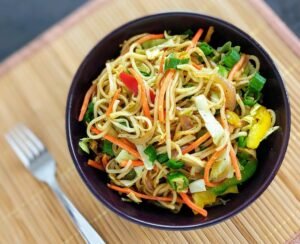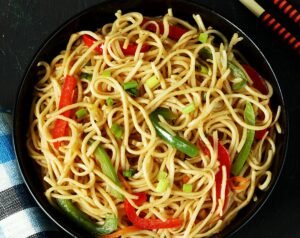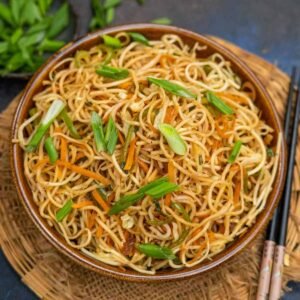The flavor of these hakka noodles is so scrumptious that you will find yourself dying for more. A vegan dish that is full with vegetables and button mushrooms is going to be shared with you. Haka noodles, which are stir-fried noodles, are a popular dish in Indo-Chinese cuisine. They are relatively simple to prepare. You will find it being prepared and served in a great number of Chinese cuisine places and restaurants that are located on the streets of India. In addition to being well-liked by children, Hakka noodles are also well-liked by adults.
Hakka Noodles – A Popular Indo-Chinese Cuisine
Two distinct types of Indian-Chinese food, which is commonly referred to as Hakka cuisine in the Indian diaspora, are offered to consumers: Both the vegetable hakka noodles and the chicken hakka noodles get their names from the Han Chinese ethnic grouping that they are developed from. Beginning in the third century, these individuals have been moving around in a sporadic manner. Consequently, they were exposed to a wide range of flavors and tastes as they traveled along the path.

Hakka Noodles Vs Regular Noodles
No one can refute the fact that everyone takes pleasure in gulping down delectable noodles, regardless of whether they are Hakka Noodles or Regular Noodles, which are also referred to as Chowmein). On the other hand, there are instances when you could find yourself wondering, “What is it about Hakka Noodles that sets them apart from regular noodles?” Allow us to walk you through the distinctions that exist between the two.
Key Differences Between Hakka Noodles and Regular Noodles
- Hakka Noodles: Hakka noodles are the name given to the approach that the Hakka Chinese take to the preparation of noodles. These individuals, who are also known as the Han Chinese or Hakka Han, have connections to the provinces of Guangdong, Jiangxi, Guangxi, Sichuan, Hunan, and Fujian in China. Additional names for these individuals include the Han Chinese. Over the course of time, the majority of these individuals moved to various locations across the globe, with India appearing to be one of their primary destinations. After arriving in India, the Hakka Chinese eventually made their home in Tangra, which is often referred to as India’s Chinatown.
- Regular Noodles or Chowmein: In Mandarin, the word “chowmein” is referred to as “Chao” or “Mian.” A significant portion of it is cooked by members of the Taishanese community, who are predominantly located in the southern part of the Guangdong province in China. Chowmein, also known as regular noodles, are normally prepared in accordance with the instructions provided by the ancient Taishanese.
This is the primary differences between Hakka Noodles and Chowmein, despite the fact that there is no obvious variation in the preparation of Hakka Noodles and Chowmein. The fact that chowmein and Hakka noodles are the same dish is something that is common knowledge all throughout the world. It doesn’t matter if you’re looking for a vegetarian or non-vegetarian version of hakka noodles; they constitute the most mouthwatering dish, and you can simply find them online.
Different Dishes that can be Prepared Using Hakka Noodles
The Hakka cuisine that is served in India is an adaption of the Hakka meals that were originally served in Taiwan. Because of the proliferation of Indo-Chinese cuisine in India, the best Chinese Hakka noodles have become one of the most well-known street meals in the country. In this article, we will discuss some of the sophisticated recipes that can be made with Hakka noodles.
A. SOUPS
- Manchow Soup: The manchow soup is one of the most well-known examples of a hot soup that comes from the Indo-Chinese cuisine. Stir-fried vegetables and manchow noodles are added to a pot of hot water that has been seasoned with aromatics and seasonings in order to produce a dish that is not only delectable but also rich in nutrients.
- Chicken Soup: Using a pot filled with boiling water, the chicken soup dish can be prepared in fifteen minutes. It is the best comfort dinner in a bowl since it contains chicken, noodles, vegetables, herbs, and everything else that is necessary to make it such.
B. MAIN MEAL
- Chicken Noodles: In this well-known Indo-Chinese meal, delicate chunks of chicken are combined with noodles that are bursting with flavor. The flavorful broth not only improves the flavor of the dish but also complements the different textures that it contains, which is why it is a popular choice for both speedy dinners and special events. Not only are chicken noodles a scrumptious and diverse culinary delight, but they may also be eaten hot as a substantial soup or stir-fried with vegetables as spicy Hakka noodles.
- Schezwan Noodles: Schewan sauce and noodles are the ingredients that go into making this spicy vegetarian version of Schewan noodles. The noodles can be produced by adding solely chicken pieces for non-vegetarian Schezwan noodles, or by adding vegetables such as capsicum, cabbage, and carrot slices for vegetarian Schezwan noodles.
C. APPETIZERS
- Spring Rolls: Spring rolls, a popular snack in China, are rolls that are fried until they are crisp and then filled with a tasty blend of vegetables and fried noodles. In order to create these delectable spring rolls, hot portable pockets of seasoned veggies are wrapped and deep-fried. These spring rolls are a snack that can be adapted in an infinite number of ways and are wonderfully dippable.
- Noodles Bread Rolls: The tasty bread rolls are a well-known snack that anyone would cherish the opportunity to enjoy. In the beginning, vegetables such as sliced carrots, capsicum, cabbage, and noodles, together with sliced onions, are fried in a skillet and then set aside. After that, these fried vegetables are stuffed into round-shaped bread and fried in oil. Once the color changes to brown, the noodles bread rolls are ready to be served.
D. SALADS
- Sesame Ginger Noodle Salad: In order to create a noodle salad that is exceptionally seasoned, the noodles are mixed with a wide range of colorful vegetables. Toss in any other veggies that you are using, along with a sauce that is sweet and sour, ginger-garlic-sesame, and the crunch of purple cabbage and red bell peppers, carrots, and broccoli that has been steamed.

Nutritional Profile of Hakka Noodles
Let us know the Hakka noodles nutrition facts that you should be aware of, before intaking it!
One medium cup of Chinese Hakka noodles covers 390 kcal. It comprises 50% carbohydrates, 20% protein, and 30% fat.
The nutritional value of 100 gm hakka noodles includes –
Energy – 1092.44kJ/261.35kcal
Fat – 9.19g (of which saturates 2.18g)
Carbohydrates – 37.17g (of which sugars 22.18g)
Protein – 7.49g
Salt – 43.49g
Fibre – 0
Health Benefits of Hakka Noodles
Once you have gained an understanding of the benefits of Hakka noodles and how they are beneficial to your health, this guide will assist you in preparing one of the most delicious Hakka noodles.
- High In Protein: To make Hakka noodles, wheat flour, which is rich in protein, is used in the preparation process. Consequently, vegetarians are able to obtain a substantial amount of protein from them.
- Low In Fat And Calories: Because of their low calorie and fat content (between 150 and 200), Hakka noodles are an excellent choice for individuals who are attempting to reduce their body fat percentage.
- Good For Digestion: There is a high concentration of dietary fiber in Hakka noodles, which is essential for maintaining a healthy digestive tract.
- Comprises Essential Nutrients: Vitamins B and E, iron, and zinc are some of the essential minerals that are included in Hakka noodles. These nutrients are critical for sustaining excellent health.
- Increases Energy Levels: Carbohydrates, which are the primary source of energy for the body, may be found in plenty in Hakka noodles.

Ingredients for Hakka Noodles Recipe
1. Hakka Noodles – Use any Indian brand of Hakka Noodles. I have used Ching’s Hakka Noodles. Note that these noodles is made with all-purpose flour so if you prefer a healthier version, then use whole wheat noodles or soba noodles (buckwheat noodles)
2. Veggies: You can add veggies of your choice. Mushrooms give a meaty texture and umami flavor. If you do not like mushrooms you can skip them. You can choose from the following list of veggies
- cabbage (green or red)
- carrots
- french beans (green beans)
- zucchini
- broccoli
- button mushrooms or cremini mushrooms
- capsicum (bell pepper)
- spring onions (scallions) or regular onions
3. Soy sauce: Try to use naturally fermented soy sauce as it gives a lovely fermented taste and flavor to the noodles. You can even use bragg liquid aminos or tamari instead.
4. Toasted sesame oil – The noodles get a lovely hint of smokiness from toasted sesame oil. But do not worry if you do not have toasted sesame oil. Just use any other neutral tasting oil like sunflower oil or safflower oil.
5. Herbs and spices: Garlic, dry red chillies, celery or coriander leaves (cilantro) are the herbs and spices added. Celery is not available everywhere in India. So if you do not have celery, then just skip it. Use green chillies instead of dry red chillies.
6. Rice vinegar: Instead of rice vinegar you can add white vinegar or apple cider vinegar. You can even use rice wine or mirin. Both rice vinegar and rice wine give a distinct flavor and aroma to the dish.
Note on Celery
There are a lot of Indian readers who ask me about celery and where they can purchase it. Celery is a herb that may be found in close proximity to the majority of superstores and supermarkets in the metropolitan areas of India.
In addition, celery can be grown in a container. It is possible to either plant the seeds or purchase the plant from a nursery. One of the most effective methods is to cut the celery off at its base and then put the base in the ground. A celery bush from my balcony herb garden is shown here for your perusal.
How to make Hakka Noodles
Prepare Veggies and Cook Noodles
- To begin, cut all of the vegetables very finely and set them aside. As an additional option, you might use a food processor to shred or grate the vegetables. Carrots, French beans, spring onions, button mushrooms, capsicum, and cabbage are some of the vegetables that I have utilized.
- Put 4.5 cups of water, a quarter teaspoon of salt, and a few drops of oil into a pot or skillet and bring it to a boil.
- Include the hakka noodles, which weigh 200 grams.
- Prepare the hakka noodles in accordance with the directions provided on the package. The noodles need to be cooked until they are al dente, which means they are almost done.
- Utilize a colander to drain the cooked noodles. And finally, give the noodles a thorough washing with clean water. Because of this, the cooking process is halted, and the starch is extracted.
- 1.50 teaspoons of toasted sesame oil should be added.
- In order to ensure that the noodles are evenly covered with oil, give them a good toss. Stickiness is eliminated from them as a result of this.
Stir Fry Spices, Vegetables
- Heat 2 tablespoons sunflower oil (or any neutral tasting oil) in a frying pan or wok. On a medium-low to medium heat, first sauté 2 to 3 dry red chilies (broken and seeds removed) and 1.5 teaspoon finely chopped garlic for about a minute.
- Increase the heat a bit and then add the 3 to 4 small spring onions (finely chopped), 8 to 10 french beans (finely chopped). Stir fry for about 3 minutes.
- Add the 4 to 5 button mushrooms (finely chopped), 1 small to medium carrot (finely chopped) and 1 teaspoon finely chopped celery and continue stir-frying.
You can also add ½ cup finely chopped cabbage and 1 small to medium capsicum at this step. For the hakka noodles video in the post, cabbage is added. - Stir fry for about 5 to 6 minutes till the edges of the veggies start to slightly brown. I like the veggies to be cooked more, than what is the norm usually for this recipe. You can cut down on the stir frying time, if you prefer half cooked or more crunchy veggies.
- Add 1.5 teaspoon soy sauce and mix well.
Make Hakka Noodles
- Add the cooked noodles. Mix, keep on tossing and stir-fry noodles for 1 to 2 minutes.
- Season with salt and crushed black pepper as per taste. Add ¼ teaspoon rice vinegar or white vinegar or rice wine.
- Toss well again and stir fry for a minute. Switch off the flame and add 1 to 2 tablespoons spring onion greens and mix well. Or you can garnish with spring onions while serving.
- Serve Hakka Noodles hot as it is or accompanied with an Indo Chinese dish like Gobi Manchurian or Paneer Manchurian or chilly mushroom or mushroom manchurian.

Expert Tips for Best Hakka Noodles
- Chopping veggies: The veggies added to noodles have to really chopped fine or cut into julienne or shredded as all the stir frying is done at a medium to high heat and in less time.
- Cooking noodles: Boil noodles till they are al dente – meaning having a slight bite to them. The noodles are again stir-fried on a high heat which makes them cook again. You don’t want to have overcooked or pasty noodles.
- For non-sticky noodles: Rinse the cooked noodles in fresh water very well. This method stops the cooking process and removes the starch. Toss and mix then cooked noodles with some oil. This gets rid of the stickiness from them and they do not become lumpy.
- Frying pan or Wok: Make sure to use a wok or kadai or a frying pan with handles, so that you keep on moving the pan when tossing and stir-frying them. Cast iron or carbon steel pans work great for stir frying on high heat but you can easily make these noodles in a regular Indian kadai or even a frying pan.
- Authentic Chinese flavors: Though they can be skipped, but to get an authentic Chinese style taste and flavor, I recommend adding these three ingredients which make a lot of difference to the final dish. You can add all or either one of them.
- Toasted sesame oil
- Celery
- Rice vinegar or rice wine.
- Stir-frying: Usually in restaurants and street stalls, the ingredients are stir fried at a very high heat which gives that smoky flavor to the dish. In a regular home kitchen it is difficult to replicate such a high heat. So you can use a medium to medium-high or high heat of your burner stove and make the recipe. For non-stick pans, stir fry on medium heat.
- Gluten-free options: To make gluten-free version use gluten-free noodles and tamari or bragg liquid aminos.

